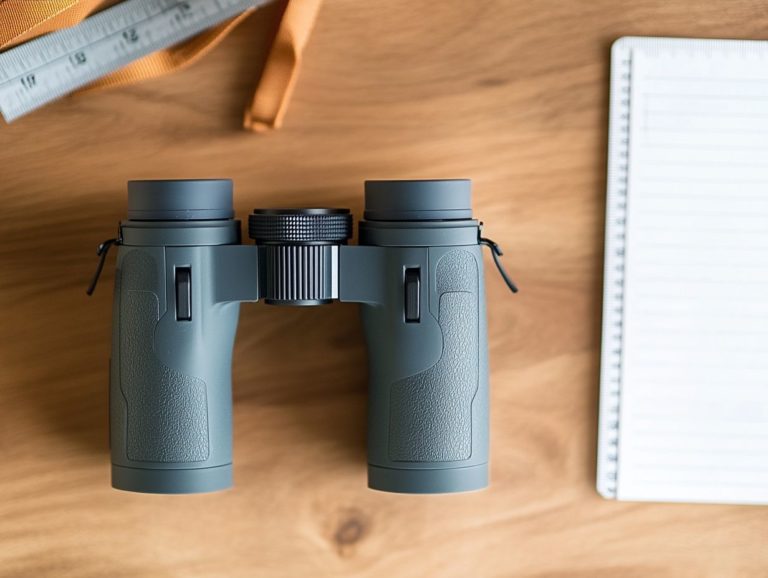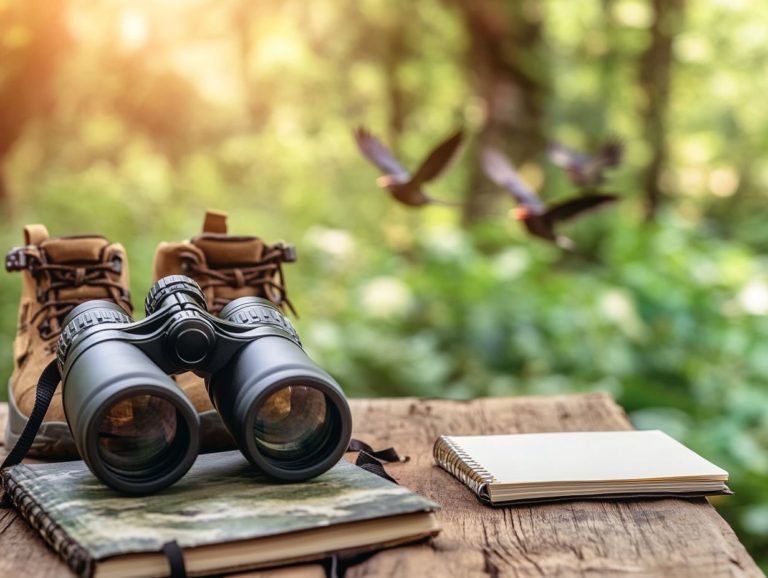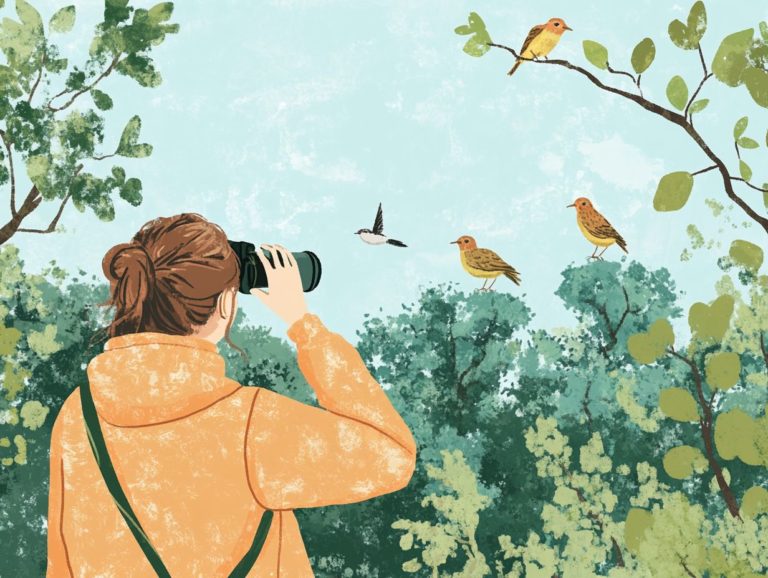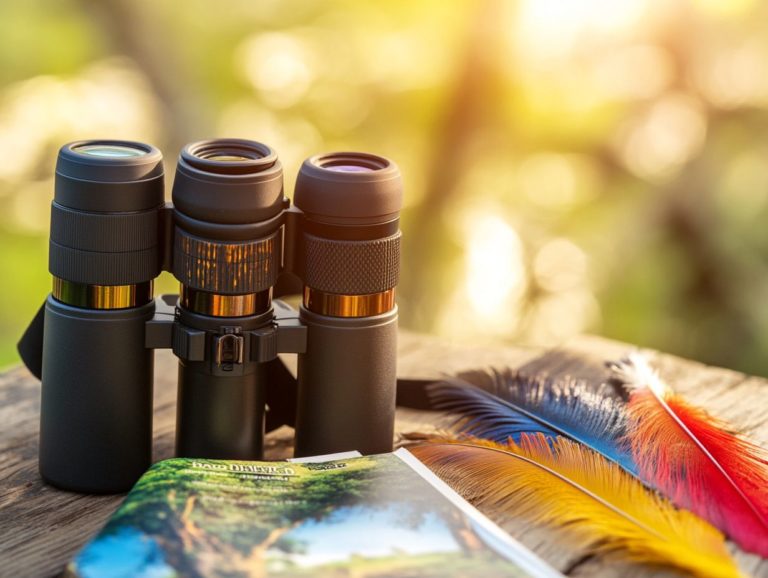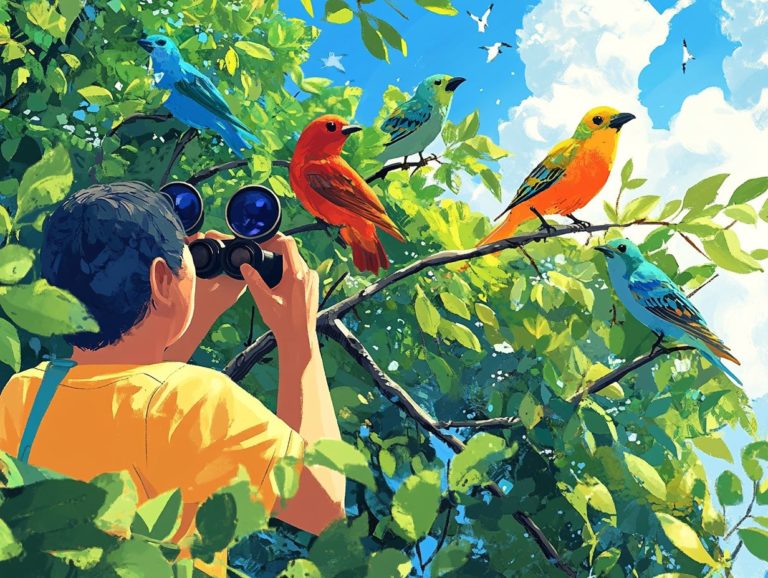How to Choose Binoculars for Long-Distance Birding
Birdwatching can be an exhilarating experience, especially with the right gear.
Choosing the perfect binoculars is key for spotting those elusive birds. This guide will help you identify your birding needs, from setting your goals to evaluating features like magnification and weight.
We’ll explore different types of binoculars for long-distance birding and share tips for testing and maintaining them.
Get ready to transform your birdwatching adventures! Let s dive in!
Contents
- Key Takeaways:
- Understanding Your Birding Needs
- Factors to Consider When Choosing Binoculars
- Types of Binoculars for Long-Distance Birding
- Tips for Trying Out and Comparing Binoculars
- Maintaining and Protecting Your Binoculars
- Frequently Asked Questions
- What factors should I consider when choosing binoculars for long-distance birding?
- What is the ideal magnification for long-distance birding?
- Do I need a large objective lens for long-distance birding?
- What is the recommended field of view for long-distance birding?
- Should I prioritize waterproof and fogproof features for long-distance birding?
- Are there any other important features to look for in binoculars for long-distance birding?
Key Takeaways:

Understanding Your Birding Needs
Understanding your birding needs is essential for an enjoyable experience and making informed purchases, especially when choosing a camera for bird watching or selecting binoculars.
Whether you re a beginner or a seasoned birder, knowing whether you want to spot rare species or join local events will guide you to the right tools.
Important features include image clarity, magnification, and comfort, which ensure you make the most of every birdwatching moment.
Identifying Your Birding Goals
Identifying your birding goals helps you choose the right equipment for an enhanced experience.
For instance, if you want to submit sightings to eBird, quality binoculars and a good field guide will simplify identification. Joining Audubon Society events can connect you with other birders and provide insights into local wildlife.
If you re a casual watcher, lightweight gear and mobile apps can make tracking sightings easy during spontaneous outings. Knowing your goals enhances your experience and appreciation for the amazing diversity of birds.
Factors to Consider When Choosing Binoculars
Choosing the right binoculars involves considering magnification, field of view, and image clarity. For birding enthusiasts, understanding specs like the 8×42 configuration can drastically improve your viewing experience.
Waterproof and fogproof features add durability, ensuring your gear withstands various weather conditions.
Magnification and Objective Lens Size
Magnification and objective lens size are key when choosing binoculars. The popular 8×42 configuration balances power and usability.
This setup gives you clear views of distant birds while keeping a wide field of vision, making it easier to track fast-moving subjects. Higher magnifications like 10x or 12x offer sharper details but narrow your field of view, making quick sightings trickier.
A larger lens collects more light for better visibility in low-light situations but can add weight. Many birders find the 8×42 model strikes the perfect balance providing excellent light-gathering without sacrificing portability, which is vital for long hours outdoors.
Field of View and Close Focus Distance
The field of view and close focus distance the closest distance you can see details clearly of your binoculars play a pivotal role in shaping your birdwatching experience. They influence how much of the landscape you can take in at once and how intimately you can connect with your avian companions.
A wider field of view enables you to track birds in flight with ease, allowing you to capture their graceful arcs as they dance across the sky. This expansive perspective broadens your spotting opportunities and aids in recognizing the behavioral patterns of various species.
Close focus distance is a game-changer! It lets you appreciate the intricate details of feather patterns and subtle color variations that might otherwise escape your notice. For those passionate about ornithology or simply reveling in nature, grasping these optical features can elevate an ordinary outing into a captivating exploration of the avian world.
Weight and Comfort
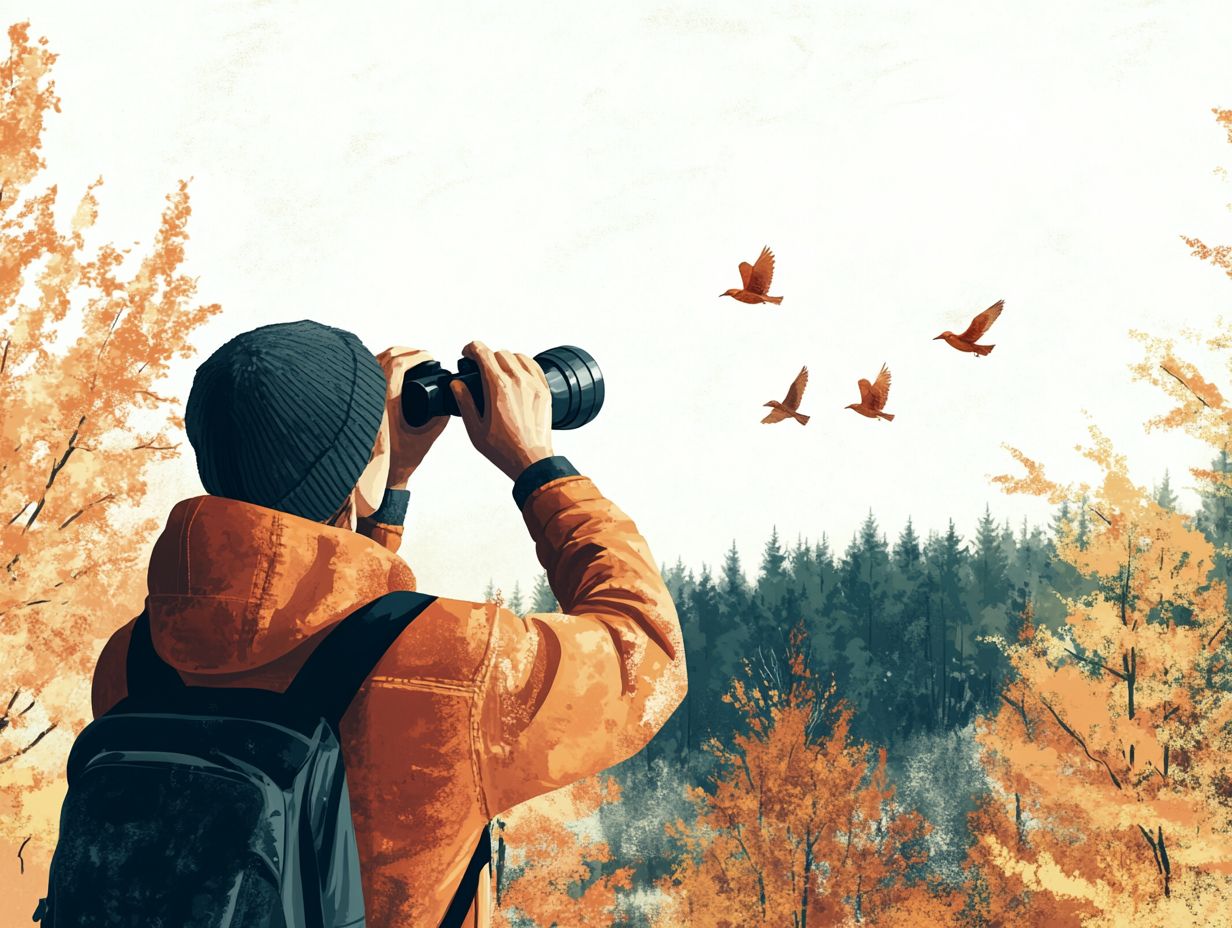
When choosing binoculars, weight and comfort are paramount, especially for those long birdwatching sessions where ease of use greatly enhances your enjoyment. For a deeper understanding, check out how to evaluate binoculars for bird watching.
For passionate birdwatchers like yourself, the last thing you need is tired arms or unwieldy gear getting in the way of the experience. This makes it essential to consider the weight of the binoculars you select. Opting for lighter models not only boosts portability making them easier to carry during extended hikes but also elevates your overall observation experience.
Features such as ergonomic grips, adjustable eyecups, and well-balanced designs are game-changers for user comfort. They allow you to spend hours scanning the skies without feeling strained. Models with padded neck straps distribute weight evenly, reducing fatigue and ensuring that you can focus on the beauty around you with ease and relaxation throughout the day.
Optical Coatings and Image Quality
Optical coatings are essential for elevating image quality, ensuring your binoculars provide bright, clear, and sharp views that are crucial for birdwatching enthusiasts.
These specialized coatings are meticulously designed to manipulate light as it traverses the lenses. They significantly impact light transmission rates and overall image clarity. You ll find several types of coatings available, including:
- Single-layer: Basic coating for light transmission
- Multi-layer: Enhanced performance for better clarity
- Fully multi-coated: Excels in light throughput, ideal for low-light conditions
If you re in the market for high-performing binoculars, you understand that the quality of these coatings can profoundly influence your viewing experience. They allow for detailed observations of wildlife that can take your birdwatching to the next level. Don’t miss out on the stunning details in nature choose the right coatings for your binoculars!
Types of Binoculars for Long-Distance Birding
In the realm of long-distance birding, selecting the right binoculars can significantly elevate your viewing experience. To enhance your skills, consider using binoculars effectively for bird identification. You have two primary designs to consider: Porro prism and roof prism binoculars, each configuration bringing distinct advantages to the table.
Porro prism models often offer a wider field of view, perfect for spotting those elusive birds in the distance. On the other hand, roof prism binoculars are typically more compact and lightweight, making them an excellent choice for travel and extended birdwatching adventures.
By understanding these differences, you ll be well-equipped to make informed purchasing decisions that enhance your birding pursuits.
Porro Prism vs Roof Prism
Choosing between Porro prism and roof prism binoculars can shape your birdwatching experience. Each design has its unique optical advantages.
When exploring binoculars, you’ll notice that lens design varies between types. This can profoundly influence the clarity and brightness of images under different lighting conditions. For example, as a birdwatcher, you might find the wider field of view provided by Porro prisms particularly appealing. It makes tracking elusive birds in dense foliage much easier.
If weight and portability matter to you, roof prism models are a great option. Their streamlined design allows for compact storage and effortless handling during long treks. This balance of usability and performance is essential in various birdwatching scenarios, whether you re navigating rugged trails or enjoying feathered visitors in your backyard.
Choosing the right binoculars can boost your comfort and make every birdwatching adventure even more exciting! For tips, check out how to select binoculars for bird watching tours.
Full-Sized vs Compact
Full-sized and compact binoculars each have unique roles for birdwatchers, offering distinct advantages tailored to your specific birding pursuits.
With full-sized models, you typically enjoy enhanced optical performance thanks to their larger objective lenses. These lenses capture more light, delivering clearer and brighter images perfect for detailed observations of distant species.
On the flip side, compact binoculars excel in portability and convenience. They re lightweight and easy to carry, making them an excellent choice for long hikes or when traveling to birdwatching hotspots.
While full-sized binoculars shine in low-light conditions, compact varieties excel when you need to make quick observations without the burden of extra weight. Understanding how to balance optical quality with portability will help you select the right tool for your unique scenarios, whether you re soaking in the tranquility of a local reserve or witnessing migration along a coastal route.
Tips for Trying Out and Comparing Binoculars
When you’re in the market for new binoculars, taking the time to conduct thorough tests and comparisons can elevate your birdwatching experience. Understanding what makes a great pair of bird watching binoculars can help you choose a model that aligns perfectly with your unique needs and preferences.
Testing for Comfort and Ease of Use
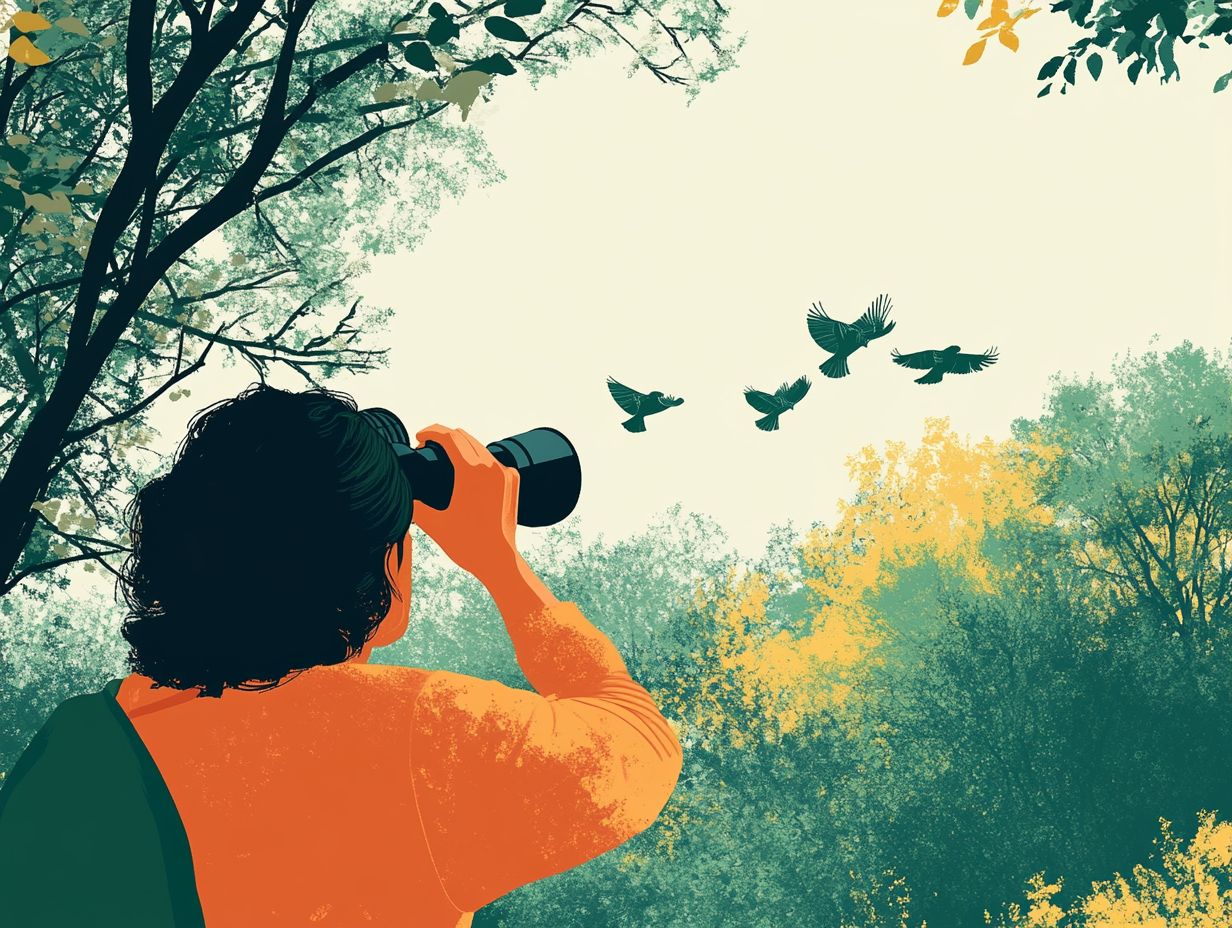
Testing for comfort and ease of use is vital when selecting binoculars. These factors greatly enhance your birdwatching enjoyment.
To ensure pleasurable outings, pay close attention to design elements, such as the shape and size of the body. You ll want something that offers an easy grip during extended observations. Ergonomic features, like the positioning of the focus wheel and weight distribution, are key to comfort during prolonged use. A textured grip can make all the difference in maintaining control, especially when conditions are wet or challenging.
Ultimately, choosing a well-designed pair can elevate a simple birdwatching trip into a delightful adventure, allowing you to focus on the beauty of wildlife rather than any discomfort.
Assessing Image Quality and Clarity
Assessing image quality and clarity is crucial when selecting binoculars. These factors dictate how effectively you can observe and identify birds in their natural habitats.
To achieve the utmost clarity, evaluate sharpness by focusing on distinct edges in the image during testing. Pay attention to fine details in feathers or foliage; these nuances demonstrate how well the binoculars handle resolution.
Color accuracy is equally important. Vibrant, true-to-life colors elevate your experience, making it easier to identify different bird species. Low-light performance is another vital aspect, especially beneficial for early morning or late evening observations.
By emphasizing these key evaluation methods, you can make a more informed choice, ultimately enhancing your birdwatching adventures.
Don’t miss out on the perfect birdwatching experience test your binoculars today!
Maintaining and Protecting Your Binoculars
Maintaining and protecting your binoculars is essential for ensuring their longevity and optimal performance. This is especially important for passionate birdwatchers who rely on these instruments to spot and identify wildlife.
Taking time to care for your binoculars enhances your viewing experience, allowing you to observe nature with clarity and precision.
Cleaning and Storage Techniques
Effective cleaning and storage techniques are crucial for keeping your binoculars in peak condition over the years.
Proper upkeep not only enhances your visual clarity but also prolongs the lifespan of these essential outdoor tools.
To clean the lenses, start by using a soft, lint-free cloth to gently wipe away dust and fingerprints. For stubborn smudges, use a lens cleaning solution a special liquid designed to clean optical surfaces.
Protect your binoculars with a harness or case during transport. This safeguards against accidental drops and harsh weather. Store your binoculars in a cool, dry place, ideally in a padded case, to prevent moisture damage and keep them functioning beautifully.
Additional Accessories for Birding
Investing in accessories can elevate your birdwatching experience by providing convenience and protection for your binoculars.
Consider a high-quality binocular harness; it dramatically increases comfort during lengthy outings by evenly distributing weight across your shoulders and alleviating neck strain.
Durable cases are essential as they shield your equipment from the rigors of outdoor adventures, guarding against scratches and unintentional drops.
A reliable cleaning kit is vital for keeping your optics crystal clear, ensuring that every birding moment is as vibrant as possible. These accessories enhance usability and extend the lifespan of your binoculars, allowing you to immerse yourself in the beauty of nature.
Frequently Asked Questions
What factors should I consider when choosing binoculars for long-distance birding?
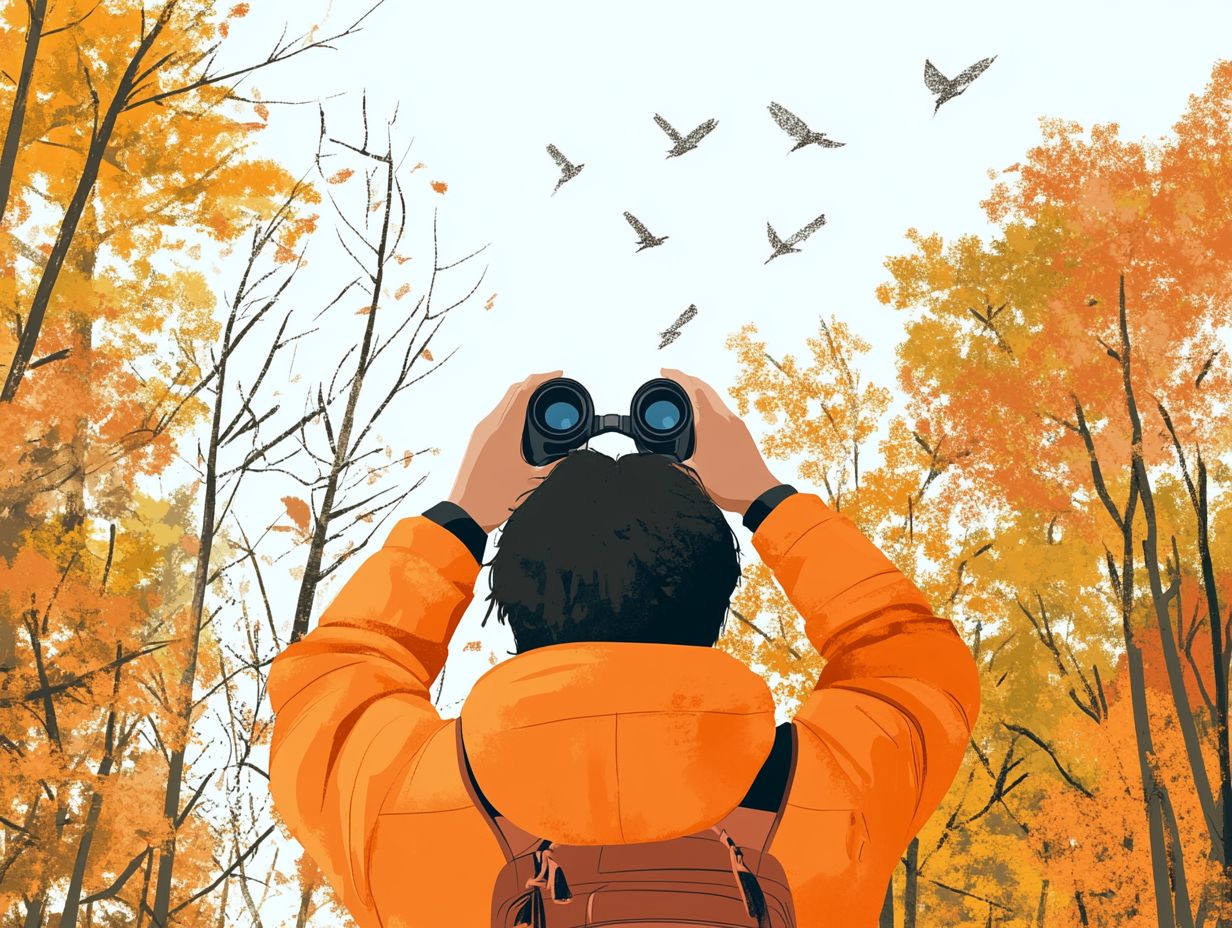
When selecting binoculars for long-distance birding, consider the magnification, objective lens size, field of view, and optical quality. For more detailed guidance, check out these tips for choosing binoculars for bird photography.
What is the ideal magnification for long-distance birding?
The ideal magnification for long-distance birding is between 8x and 10x. This range provides enough magnification to see birds at a distance while maintaining image stability. For more insights, check out this guide on how to choose a spotting scope for bird migration.
Do I need a large objective lens for long-distance birding?
A larger objective lens, typically 42-50mm, can offer a brighter and clearer image for long-distance birding. However, this also results in a heavier and bulkier pair of binoculars.
What is the recommended field of view for long-distance birding?
A wide field of view, around 350-450 feet at 1000 yards, is recommended for long-distance birding. This helps you scan for birds more easily and track them in flight, especially when using the best binoculars for backyard bird watching.
Should I prioritize waterproof and fogproof features for long-distance birding?
Yes! These features are important for long-distance birding since you may face various weather conditions in the field. They help protect the internal components of the binoculars.
Are there any other important features to look for in binoculars for long-distance birding?
Other important features include the type of prism used (roof or porro), eye relief for eyeglass wearers, and the weight and size of the binoculars for comfortable handling during extended use.

